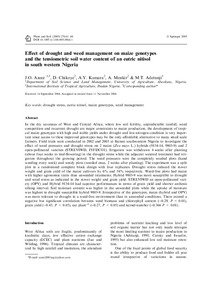| dc.contributor.author | Azeez, J. |
| dc.contributor.author | Chikoye, D. |
| dc.contributor.author | Kamara, A. |
| dc.contributor.author | Menkir, A. |
| dc.contributor.author | Adetunji, M. |
| dc.date.accessioned | 2019-12-04T11:18:57Z |
| dc.date.available | 2019-12-04T11:18:57Z |
| dc.date.issued | 2005 |
| dc.identifier.citation | Azeez, J., Chikoye, D., Kamara, A., Menkir, A. & Adetunji, M. (2005). Effect of drought and weed management on maize genotypes and the tensiometric soil water content of an eutric nitisol in south western Nigeria. Plant and Soil, 276(1), 61-68. |
| dc.identifier.issn | 0032-079X |
| dc.identifier.uri | https://hdl.handle.net/20.500.12478/3361 |
| dc.description.abstract | In the dry savannas of West and Central Africa, where low soil fertility, unpredictable rainfall, weed competition and recurrent drought are major constraints to maize production, the development of tropical maize genotypes with high and stable yields under drought and low-nitrogen condition is very important since access to these improved genotypes may be the only affordable alternative to many small scale farmers. Field trials were conducted in 2002 and 2003 at Ikenne southwestern Nigeria to investigate the effect of weed pressures and drought stress on 2 maize (Zea mays L.) hybrids (9134-14, 9803-9) and 2 open-pollinated varieties (STREVIWD, IYFDCO1). Irrigation was withdrawn 4 weeks after planting (about four weeks to mid-flowering) in the drought stress while the adjacent watered treatment had irrigation throughout the growing period. The weed pressures were the completely weeded plots (hand weeding every week) and weedy plots (weeded once, 2 weeks after planting). The experiment was a split plot in a randomized complete block design with four replicates. Drought stress reduced the stover weight and grain yield of the maize cultivars by 6% and 34% respectively. Weed-free plots had maize with higher agronomic traits than unweeded treatments. Hybrid 9803-9 was more susceptible to drought and weed stress as indicated in the stover weight and grain yield. STREVIWD an open-pollinated variety (OPV) and Hybrid 9134-14 had superior performances in terms of grain yield and shorter anthesis silking interval. Soil moisture content was higher in the unweeded plots while the uptake of moisture was highest in drought susceptible hybrid 9803-9. Irrespective of the genotypes, maize (hybrid and OPV) was more tolerant to drought in a weed-free environment than in unweeded conditions. There existed a negative but significant correlation between weed biomass and chlorophyll content (−0.29, P < 0.01), grain yield (−0.45, P < 0.05), ear plant−1 (−0.27, P < 0.05) and kernel-number (−0.366 P < 0.01). |
| dc.language.iso | en |
| dc.subject | Drought Stress |
| dc.subject | Eutric Nitisol |
| dc.subject | Maize Genotypes |
| dc.subject | Weed Management |
| dc.subject | Nutrient |
| dc.subject | Weeded Plots |
| dc.title | Effect of drought and weed management on maize genotypes and the tensiometric soil water content of an eutric nitisol in south Western Nigeria |
| dc.type | Journal Article |
| dc.description.version | Peer Review |
| cg.contributor.affiliation | Federal University of Agriculture, Nigeria |
| cg.contributor.affiliation | International Institute of Tropical Agriculture |
| cg.coverage.region | Africa |
| cg.coverage.region | West Africa |
| cg.coverage.country | Nigeria |
| cg.isijournal | ISI Journal |
| cg.authorship.types | CGIAR and developing country institute |
| cg.iitasubject | Nutrition |
| cg.iitasubject | Maize |
| cg.iitasubject | Genetic Improvement |
| cg.iitasubject | Disease Control |
| cg.iitasubject | Pests Of Plants |
| cg.iitasubject | Plant Breeding |
| cg.iitasubject | Plant Genetic Resources |
| cg.iitasubject | Weeds |
| cg.iitasubject | Handling, Transport, Storage And Protection Of Agricultural Products |
| cg.iitasubject | Livelihoods |
| cg.iitasubject | Plant Health |
| cg.iitasubject | Plant Production |
| cg.iitasubject | Food Security |
| cg.accessibilitystatus | Limited Access |
| local.dspaceid | 95035 |
| cg.identifier.doi | https://dx.doi.org/10.1007/s11104-005-3864-1 |

